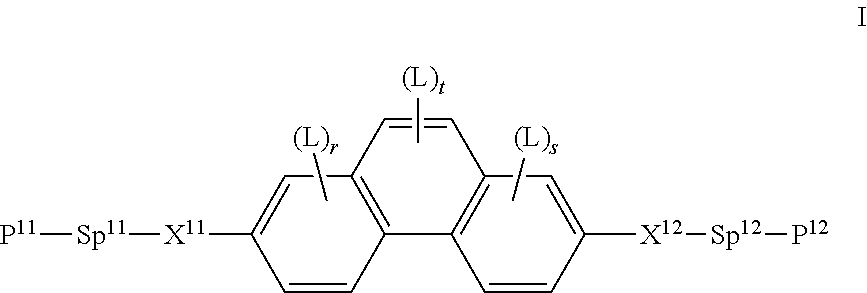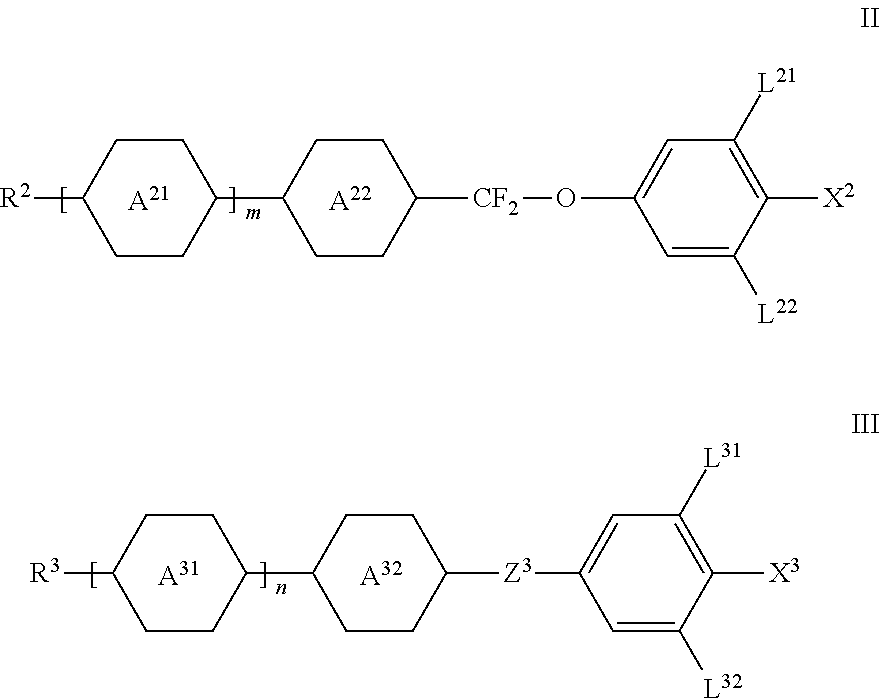Liquid-crystalline medium and liquid-crystal display
a technology of liquid crystal display and liquid crystal medium, which is applied in the field of liquid crystal display, can solve the problems of strong viewing angle dependence of contrast, inability to combine liquid crystal mixture and polymerisable component by far, and various disadvantages of liquid crystal mixture and prior art. rms, etc., to achieve the effect of short response time, low viscosity and high
- Summary
- Abstract
- Description
- Claims
- Application Information
AI Technical Summary
Benefits of technology
Problems solved by technology
Method used
Image
Examples
example 1
[0226]A liquid-crystal mixture (A) having the composition and properties as indicated in the following table is prepared.
TABLE 1Composition and properties of mixture ACompositionCompoundNo.Abbreviationc / %1PUQU-3-F8.02CCG-V-F8.03CCU-3-F3.04CPU-3-F8.55CGU-3-F8.06PGU-3-F3.57CCGU-3-F6.08CC-3-V25.09CC-3-V15.010CCP-V-113.011CCP-V2-112.0Σ100.0Physical propertiesT(N, I) =90.6°C.ne(20° C., 589.3 nm) =1.5894Δn (20° C., 589.3 nm) =0.1006ε|| (20° C., 1 kHz) =9.7Δε (20° C., 1 kHz) =6.5γ1 (20° C.) =86mPa · sk1 (20° C.) =12.9pNk3 / k1(20° C.) =1.27V0 (20° C.) =t.b.d.VRemarks: t.b.d.: to be determined
[0227]This mixture is very highly suitable for displays in IPS mode. The mixture is divided into five parts. The first part is introduced directly into an IPS cell and investigated. Alternatively 0.30%, 0.50%, 1.0% and 2.0%, respectively, of the reactive mesogen RM-1 of the formula
is added to each of the four further parts of the mixture. The resultant mixtures are introduced into IPS cells, and the reac...
example 2
[0228]A further liquid-crystal mixture (liquid-crystal mixture B) having the composition and properties as indicated in the following table is prepared.
TABLE 3Composition and properties of mixture BCompositionCompoundNo.Abbreviationc / %1PGUQU-3-F2.02CPP-3-F5.53CPU-3-F19.54PPGU-3-F0.55CC-3-V48.56CC-3-V17.07PP-1-2V17.08CPP-3-23.09CPGP-5-23.0Σ100.0Physical propertiesT(N, I) =70.3°C.ne(20° C., 589.3 nm) =1.5873Δn (20° C., 589.3 nm) =0.0992ε|| (20° C., 1 kHz) =5.7Δε (20° C., 1 kHz) =3.1γ1 (20° C.) =53mPa · sk1 (20° C.) =13.2pNk3 / k1(20° C.) =1.07V0 (20° C.) =2.13V
[0229]This mixture is very highly suitable for displays in IPS- and in FFS mode. As in Example 1, the mixture is divided into parts, here it is divided into four parts. The first part is introduced directly into an FFS cell (layer thickness 3.6 μm, W=4.0 μm, L=6.0 μm, tilt angle 2°, slit angle 10°) and investigated. Alternatively 0.30%, 0.50% and 1.0%, respectively, of the reactive mesogen RM-1, used already in example 1, is added...
example 3
[0230]A further liquid-crystal mixture (liquid-crystal mixture C) having the composition and properties as indicated in the following table is prepared.
TABLE 5Composition and properties of mixture CCompositionCompoundNo.Abbreviationc / %1PGUQU-3-F2.012CPP-3-F5.533CPU-3-F19.604CC-3-V48.745CC-3-V14.036PP-1-2V17.047CPP-3-27.038CPGP-5-23.02Σ100.00Physical propertiesT(N, I) =69.5°C.ne(20° C., 589.3 nm) =1.5862Δn (20° C., 589.3 nm) =0.0982ε|| (20° C., 1 kHz) =5.6Δε (20° C., 1 kHz) =3.0γ1 (20° C.) =51mPa · sk1 (20° C.) =t.b.d.pNk3 / k1(20° C.) =t.b.d.V0 (20° C.) =t.b.d.VRemarks: t.b.d.: to be determined
[0231]This mixture is very highly suitable for displays in IPS mode. As in Example 2, the mixture is divided into four parts. The respective parts are treated and investigated as described in example 2. The results are shown in the following table, table 6.
TABLE 6Results for mixture C stabilised with various amounts of RM-1ExampleC33.13.23.3c(RM-1) / %00.300.501.0T(N, I) / ° C.69.569.769.870.0
PUM
| Property | Measurement | Unit |
|---|---|---|
| rotational viscosity | aaaaa | aaaaa |
| rotational viscosity | aaaaa | aaaaa |
| rotational viscosity | aaaaa | aaaaa |
Abstract
Description
Claims
Application Information
 Login to View More
Login to View More - R&D
- Intellectual Property
- Life Sciences
- Materials
- Tech Scout
- Unparalleled Data Quality
- Higher Quality Content
- 60% Fewer Hallucinations
Browse by: Latest US Patents, China's latest patents, Technical Efficacy Thesaurus, Application Domain, Technology Topic, Popular Technical Reports.
© 2025 PatSnap. All rights reserved.Legal|Privacy policy|Modern Slavery Act Transparency Statement|Sitemap|About US| Contact US: help@patsnap.com



